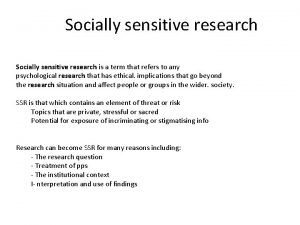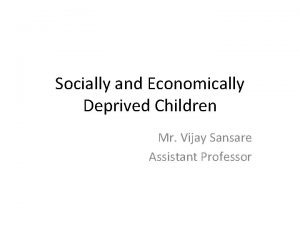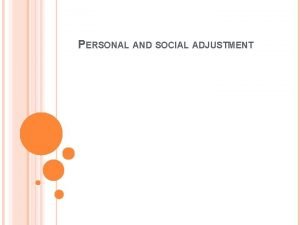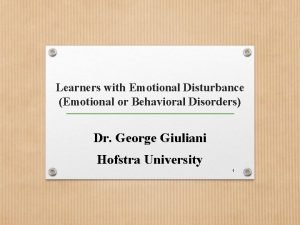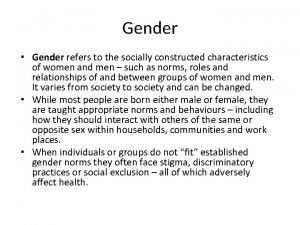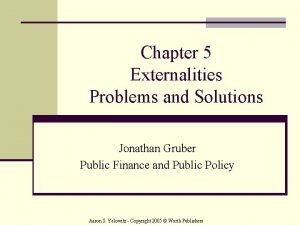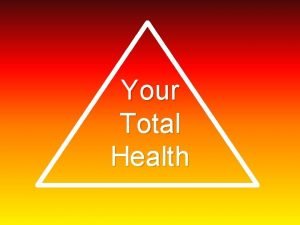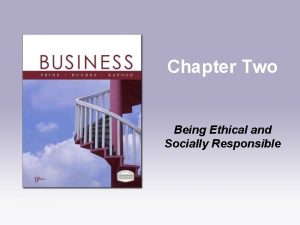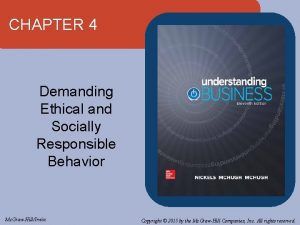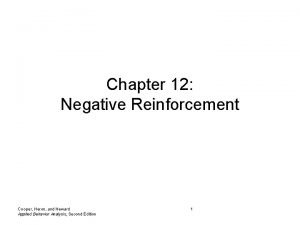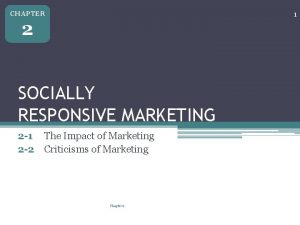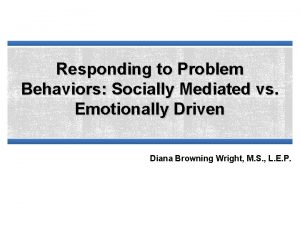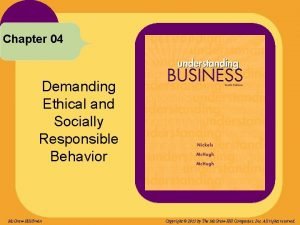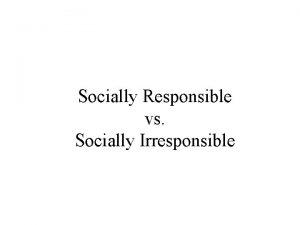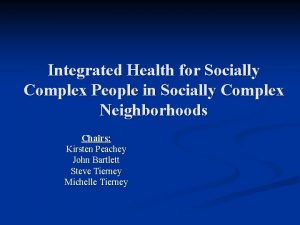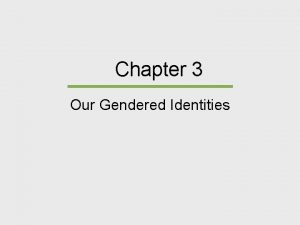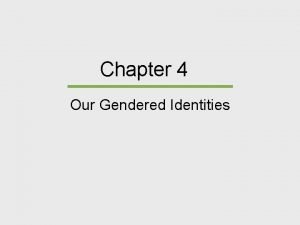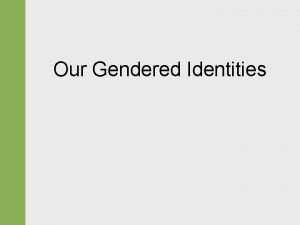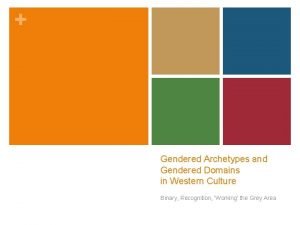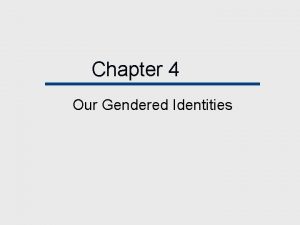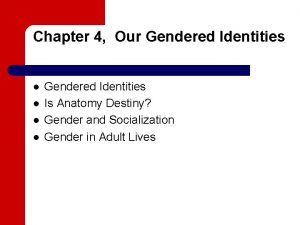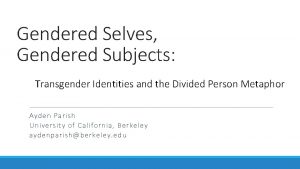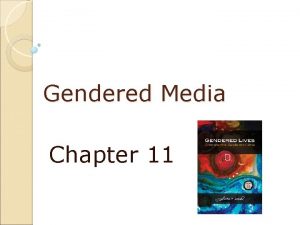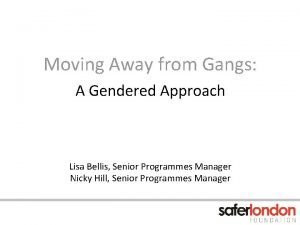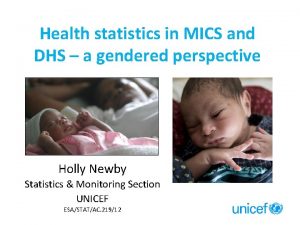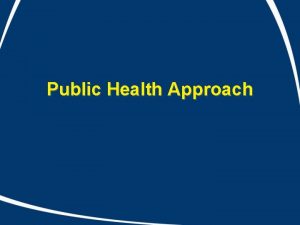A gendered approach to health To socially locate



























- Slides: 27

A gendered approach to health To socially locate gender related health problems so as to develop health improvement strategies

Sex and gender • Sex is a biological concept but gender is also sociologically constructed • Higher socio-economic status (s. e. s) is a better predictor of health than gender is • A gendered approach to health should also be targeted to address class related health problems

A gendered approach to health • Would seek to understand the way in which women’s and men’s historical, political and individual situations interact to contribute to their health or lack of it. • This understanding would assist the development of prevention and treatment programs

Risk taking behaviour • The risk taking behaviour traditionally required of men at work is related to the caring behaviour traditionally required of women at home • Traditionally, men are expected to get money to protect the home, women are expected to protect children and promote domestic harmony. (But biology is destiny no longer!)

Women’s National Health Policy and programs since 1985 • • Reproductive health and sexuality Health of ageing women Emotional and mental health Violence against women Occupational health and safety Health needs of women as carers Health effects of sex-role stereotyping

First National Men’s Health Conference 1995 • But men have higher death rates at all ages than women do. This is principally associated with higher rates of health disease and lung cancer, and with their greater rates of injury. Men attend GPs and specialist surgeries less, and give less thought to protecting their health than women do.

Comparative health of men and women • 25 -44: Mental disorders major problem (34% of total disease burden for women and 27% for men) • Depression and anxiety disorders for women • Depression, traffic accidents, alcohol related injury, HIV/AIDS for men

Comparative health of women and men • 25 -44: Cancer (second major cause of the total disease burden for women) • 25 -44: Unintentional and intentional injury are the second and third leading causes of the total disease burden for men • 45 -64+: Heart disease, cancers, cardiovascular, dementias for both sexes

Lifestyle requirements • Both sexes should eat less sugar and high fat foods, exercise more, give up smoking, reduce alcohol consumption • Generally manage their health risks better

Changing family context • Work changing, fewer children born, and expected sex roles are also changing. • This threatens traditional notions of marriage • Through Australian time use surveys, Wajcman and Bittman found that the greatest work and financial stresses are experienced by those with young children • Lower socio-economic status group also more likely to have children

Flexible and supportive work and family policies are needed • Which help people to choose and perform work and family roles without major stress • Australia has signed International Labour Organisation (ILO) Conventions in support of these goals in areas such as OHS, antidiscrimination, parental leave, child care, and in related education and service areas

Half empty or half full? • From the statistical picture one might see an epidemic of depression, anxiety, substance abuse and social breakdown • Or, are people living longer, healthier and freer lives which allow them to look more critically at problems which were once deemed inevitable or unmentionable?

How high should expectations be • Freudenberger says ‘burnout’ occurs when expectation levels are dramatically opposed to reality and the person persists in trying to reach that expectation • How should social expectations be defined for mental health – broadly, diversely and modestly rather than narrowly and highly?

Drug addiction as a way of life? Ellard says drug addiction is not a disease but a way of life, especially for the poor He says that it may be that when the ideal society has been achieved there will be little addiction Is addiction an escape from the stresses or monotony of life?

Commercial sexual exploitation of children and young people in Aust. • The dominant form of commercial sexual exploitation of young people is a survival strategy to exchange sex for accommodation, food, alcohol, cigarettes, drugs, clothes or money. • Need for emotional contact and sexual exploration also important(Nat. inq. 1998)

What is a healthy sexual relationship? • The WHO definition of sexual health is ‘the integration of physical, emotional, intellectual and social aspects of sexuality in a way that positively enriches and promotes personality, communication and love’. • N. B. This does not automatically equate virginity or monogamy with the apogee of moral goodness for either sex. (Social includes economic? )

Sexual Health Promotion • ‘The holistic process of enabling individuals and communities to increase control over the determinants of sexual health, and thereby managing and improving it throughout their lifetime’ (Nutbeam and Blakey, 1990)

Regulation of Sexual Services in NSW • Select Committee on Prostitution in NSW (1986) recommended no red light districts, but permission for consensual activity between adults, while preserving the amenity of the community at large • Brothels and parlours conforming to govt. requirements may operate in NSW

Regulation of brothels in NSW • Councils responsible for brothel establishment and operation • Land Environment Court deals with resolution of disputes related to the placement of brothels and parlours

Incidence of Brothels in NSW • In 1993 the Dept. of Health found 200 female brothels or parlours (1 or 2 self employed workers) in Sydney and 60 rural ones • 11 male and 3 transgender brothels also identified • In 1999 the SMH estimated 400 -500 brothels exist in Sydney. Most illegal and many occupied by immigrants.

Why Consumers say they visit prostitutes • Macfarlane Burnet Centre for Medical Research (1998): • Good sex (32%) • Convenient sex without commitments(20%) • Companionship & intimate contact (15%) • Alleviation of sexual frustration (13%) • Variety in partner and activity (13%)

Model Criminal Code (Standing C’tee of Attorneys General)’ 98 • Chapter 9 deals with the conditions under which prostitution might be seen as ‘sex slavery’ or ‘sex servitude’ • The appropriate relationship of the code to the treatment of illegal immigrants and those who bring them to Australia requires attention

Prostitution and Sexually Transmitted Diseases • Early 1980 s prostitutes had high rates of STDs in comparison with community • By 1996 sex workers in NSW were rarely diagnosed with bacterial STDs or infections such as HIV/AIDS, chlamydia, hepatitis B, genital warts, herpes, gonorrhoea, syphilis (Donovan and Harcourt, 1996)

Control of STDs due to: • Law reform, funding of community organisations; peer education and support groups such as the NSW Sex Workers Outreach Project • Use of condoms for vaginal and anal intercourse • Use of condoms or dental dams for oral sex • Regular check-ups at 33 sexual health centres across NSW

NSW OHS Act (1983) applies to the sex industry • An employer must provide a safe place of work and employees must work safely • NSW Work. Cover and NSW Health regard brothel workers as employees • However, brothel owners often regard them as self employed people who are renting rooms

Prostitute: self-employed or employee? • Employees have tax taken from their pay by the employer and have entitlements to holiday pay, workers compensation, etc • Self employed people pay their own tax • Streetwalkers and other self employed people generally have a much more dangerous but sometimes better paid job

Australia’s good sexual health record • Heymann’s global and regional epidemiological study of sexually transmitted diseases and AIDS (1995) indicates that Australian control of HIV/AIDS and other STDs can be favourably compared with that achieved anywhere in the world
 Becoming gendered
Becoming gendered Hyper heterosexual feminine identity
Hyper heterosexual feminine identity Carmen fought
Carmen fought Gendered verbal communication
Gendered verbal communication Paltridge discourse analysis
Paltridge discourse analysis What is the socially optimal quantity
What is the socially optimal quantity Socially valued resources
Socially valued resources What is socially sensitive research
What is socially sensitive research Socially deprived child meaning
Socially deprived child meaning Meaning of social adjustment
Meaning of social adjustment Socially maladjusted vs emotional disturbance
Socially maladjusted vs emotional disturbance Gender refers to
Gender refers to Socially optimal level
Socially optimal level Corrective tax
Corrective tax Market power market failure
Market power market failure Social health means
Social health means Socially adept definition
Socially adept definition Being ethical and socially responsible
Being ethical and socially responsible Demanding ethical and socially responsible behavior
Demanding ethical and socially responsible behavior Negative vs positive reinforcement
Negative vs positive reinforcement Socially responsible lending
Socially responsible lending Socially legitimate relationship
Socially legitimate relationship Chapter 2 socially responsive marketing
Chapter 2 socially responsive marketing Socially mediated positive
Socially mediated positive The totality of learned socially transmitted behavior
The totality of learned socially transmitted behavior Ethics lg1 shoes
Ethics lg1 shoes Datagram switching vs virtual circuit
Datagram switching vs virtual circuit Cognitive approach vs behavioral approach
Cognitive approach vs behavioral approach







